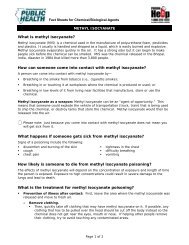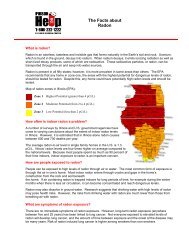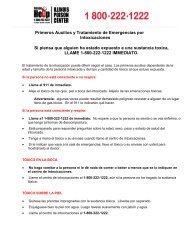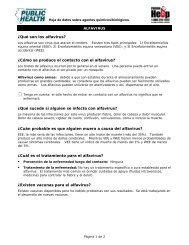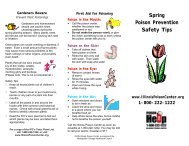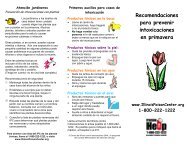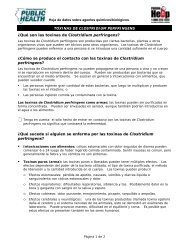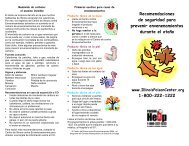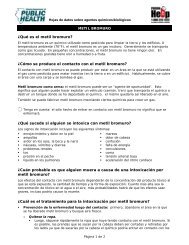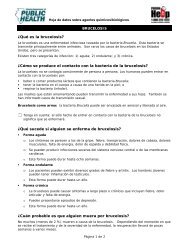What is methyl isocyanate? - Illinois Poison Center
What is methyl isocyanate? - Illinois Poison Center
What is methyl isocyanate? - Illinois Poison Center
Create successful ePaper yourself
Turn your PDF publications into a flip-book with our unique Google optimized e-Paper software.
<strong>What</strong> <strong>is</strong> <strong>methyl</strong> <strong>is</strong>ocyanate?<br />
Fact Sheets for Chemical/Biological Agents<br />
METHYL ISOCYANATE<br />
Methyl <strong>is</strong>ocyanate (MIS) <strong>is</strong> a chemical used in the manufacture of polyurethane foam, pesticides<br />
and plastics. It usually <strong>is</strong> handled and shipped as a liquid, which <strong>is</strong> easily burned and explosive.<br />
Methyl <strong>is</strong>ocyanate evaporates quickly in the air. It has a strong odor but it can begin to make<br />
people sick before the chemical can be smelled. MIS was the chemical released in the Bhopal,<br />
India, d<strong>is</strong>aster in 1984 that killed more than 3,800 people.<br />
How can someone come into contact with <strong>methyl</strong> <strong>is</strong>ocyanate?<br />
A person can come into contact with <strong>methyl</strong> <strong>is</strong>ocyanate by—<br />
Breathing in the smoke from tobacco (i.e., cigarette smoke);<br />
Breathing in or touching it at workplaces where the chemical <strong>is</strong> produced or used; or<br />
Breathing in low levels of it from living near facilities that manufacture, store or use the<br />
chemical.<br />
Methyl <strong>is</strong>ocyanate as a weapon: Methyl <strong>is</strong>ocyanate can be an “agent of opportunity.” Th<strong>is</strong><br />
means that someone could explode the vehicle of transportation (truck, train) that <strong>is</strong> being used<br />
to ship the chemical, or destroy tanks that store the chemical. Methyl <strong>is</strong>ocyanate would then be<br />
released into the air.<br />
Please note: Just because you come into contact with <strong>methyl</strong> <strong>is</strong>ocyanate does not mean you<br />
will get sick from it.<br />
<strong>What</strong> happens if someone gets sick from <strong>methyl</strong> <strong>is</strong>ocyanate?<br />
Signs of a po<strong>is</strong>oning include the following:<br />
d<strong>is</strong>comfort and burning of the skin<br />
cough<br />
chest pain<br />
Page 1 of 2<br />
tightness in the chest<br />
difficulty breathing<br />
vomiting<br />
How likely <strong>is</strong> someone to die from <strong>methyl</strong> <strong>is</strong>ocyanate po<strong>is</strong>oning?<br />
The effects of <strong>methyl</strong> <strong>is</strong>ocyanate will depend on the concentration of exposure and length of time<br />
the person <strong>is</strong> exposed. Exposure to high concentrations could result in severe damage to the<br />
lungs and lead to death.<br />
<strong>What</strong> <strong>is</strong> the treatment for <strong>methyl</strong> <strong>is</strong>ocyanate po<strong>is</strong>oning?<br />
Prevention of illness after contact: First, leave the area where the <strong>methyl</strong> <strong>is</strong>ocyanate was<br />
released and move to fresh air.<br />
o Remove clothing.<br />
Then, quickly take off clothing that may have <strong>methyl</strong> <strong>is</strong>ocyanate on it. If possible, any<br />
clothing that has to be pulled over the head should be cut off the body instead so the<br />
chemical does not get near the eyes, mouth or nose. If helping other people remove<br />
their clothing, try to avoid touching any contaminated areas.
(Methyl <strong>is</strong>ocyanate continued)<br />
o Wash affected areas.<br />
As quickly as possible, wash any <strong>methyl</strong> <strong>is</strong>ocyanate from the skin with lots of soap and<br />
water.<br />
If the eyes are burning or v<strong>is</strong>ion <strong>is</strong> blurred, rinse your eyes with plain water for 10 to<br />
15 minutes.<br />
If contact lenses are worn, remove them and put them with the contaminated clothing.<br />
Do not put the contacts back in. If eyeglasses are worn, wash them with soap and<br />
water. Eyeglasses can be put back on after they are washed.<br />
If you are wearing jewelry that you can wash with soap and water, wash it and put it<br />
back on. If it cannot be washed, put it with the contaminated clothing.<br />
o D<strong>is</strong>card contaminated items.<br />
Place the clothing and any other contaminated items inside a plastic bag. Avoid<br />
touching contaminated areas of the clothing. If you can't avoid touching contaminated<br />
areas, or you aren't sure where the contaminated areas are, wear rubber gloves or use<br />
tongs, sticks or similar objects. Anything that touches the contaminated clothing<br />
should also be placed in the bag.<br />
Seal the bag, and then seal that bag inside another plastic bag.<br />
Call the local county health department right away. (V<strong>is</strong>it<br />
www.idph.state.il.us//local/alpha.htm for a l<strong>is</strong>ting of all county health departments in<br />
Illino<strong>is</strong> or check your local phone book.)<br />
When the local or state health department or emergency personnel arrive, tell them<br />
what you did with your clothes. The health department or emergency personnel will<br />
arrange for further d<strong>is</strong>posal. Do not handle the plastic bags yourself.<br />
Treatment of illness: There <strong>is</strong> no specific treatment for <strong>methyl</strong> <strong>is</strong>ocyanate po<strong>is</strong>oning.<br />
Supportive care (intravenous fluids, medicine to control pain) <strong>is</strong> the standard treatment.<br />
Is there a vaccine for <strong>methyl</strong> <strong>is</strong>ocyanate po<strong>is</strong>oning?<br />
No, there <strong>is</strong> no vaccine for <strong>methyl</strong> <strong>is</strong>ocyanate po<strong>is</strong>oning.<br />
<strong>What</strong> should be done if someone comes into contact with <strong>methyl</strong><br />
<strong>is</strong>ocyanate?<br />
If you think that you or someone you know may have come into contact with <strong>methyl</strong> <strong>is</strong>ocyanate,<br />
contact the local county health department right away. (V<strong>is</strong>it www.idph.state.il.us//local/alpha.htm<br />
for a l<strong>is</strong>ting of all county health departments in Illino<strong>is</strong> or check your local phone book.)<br />
If you or someone you know <strong>is</strong> showing symptoms of <strong>methyl</strong> <strong>is</strong>ocyanate po<strong>is</strong>oning, call your health<br />
care provider or the Illino<strong>is</strong> Po<strong>is</strong>on <strong>Center</strong> right away. The toll-free number for the po<strong>is</strong>on center <strong>is</strong><br />
1-800-222-1222.<br />
Where can one get more information about <strong>methyl</strong> <strong>is</strong>ocyanate?<br />
U.S. Agency for Toxic Substances and D<strong>is</strong>ease Reg<strong>is</strong>try www.atsdr.cdc.gov/<br />
tfacts182.html<br />
Illino<strong>is</strong> Department of Public Health www.idph.state.il.us<br />
Illino<strong>is</strong> Po<strong>is</strong>on <strong>Center</strong> www.Illino<strong>is</strong>Po<strong>is</strong>on<strong>Center</strong>.org<br />
Page 2 of 2 Rev<strong>is</strong>ed 01/2005



